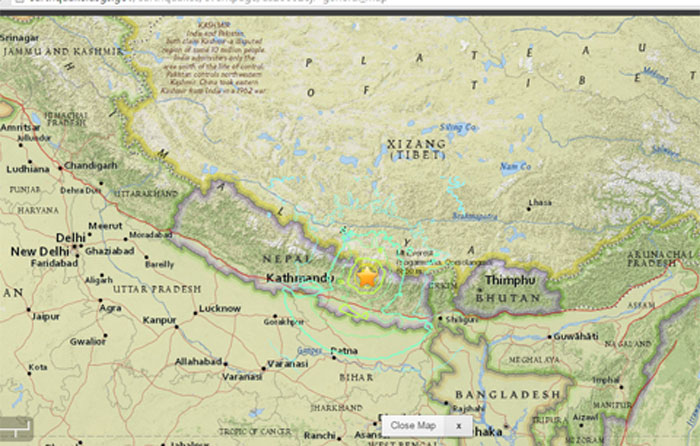Bangladesh is in the major earthquake zone. Bangladesh, being located close to the plate margins of Indian and Eurasian plates, is susceptible to earthquakes. The collision of the Indian plate moving northward with the Eurasian plate is the cause of frequent earthquakes in the region comprising Bangladesh and neighbouring India, Nepal and Myanmar.
The country is surrounded by the Himalayan Arc, the Shillong Plateau and the Dauki fault system in the north, the Burmese Arc and Arakan Yoma anticlinorium in the east, and the Naga Disang Haflong thrust zone in the northeast.
The existence of an active fault had been proved in Haluaghat of Mymenshingh, adding further risk to the vulnerability, experts expressed after 2011 tremor.
Yet another earthquake jolted Dhaka and other parts of the country around 1:08pm on Tuesday.
The quake panicked hundreds of thousands of people staying at home and commercial buildings in major cities and towns.
The earthquake was measured at 7.4 magnitude on Richter scale and its epicentre is 22 km away from Zham of China and 83 km from Katmandu of Nepal, according to US Geological Survey.
No casualties and damage to properties have yet been reported till filing of this report at 1:15pm.
A major earthquake hit the country on 25 April when Nepal was devastated by a 7.8 magnitude earthquake. Almost 10,000 people were reportedly killed in the quake.
The entire region surrounding Nepal also experienced several aftershocks.
Historically Bangladesh has been affected by five earthquakes of large magnitude (M) greater than 7.0 (Richter scale) during the 61 year period from 1869 to 1930. Among them, the mighty 8+ magnitude 1897 Great Indian earthquake in Shillong, Assam had an epicentral distance of about 230 km from Dhaka. That earthquake caused extensive damages to masonry buildings in many parts of Bangladesh including Dhaka. The 1885 Bengal earthquake (M=7.0, 170 km from Dhaka) and 1918 Srimongal earthquake (M=7.6, 150 km from Dhaka) had their epicentres within Bangladesh, they caused considerable damage locally. Two great (M>8) earthquakes occurred in Bihar in 1934 and in Assam in 1950, but they were too far to cause any damage in Bangladesh. It should be noted that large earthquakes in the region have not been occurring for quite a long time (around 75 years) and hence, the possibility of a major earthquake occurring soon is quite high.
According to Prof. Bruce Bolt of University of California at Berkeley, a world renowned seismologist, Bangladesh can be affected by large magnitude earthquakes generated in four tectonic zones, as shown in the following table:
The present generation of people in Bangladesh hasn`t witnessed any major earthquake. As a result the population has been generally complacent about the risk of earthquakes. During the last seven or eight years, the occurrence and damage caused by some earthquakes (magnitude between 4 and 6) inside the country or near the country`s border, has raised the awareness among the general people and the government as well. The damage has been mainly restricted to rural areas or towns near the epicentre, but there has been some instances of damage in urban areas 50 to 100 km away.
Dhaka, located in the central region of Bangladesh, could be affected by any of the four earthquake source zones. Another point of major concern is that there are active faults near the city also. This was realized during the 19 December 2001 magnitude 4+ Dhaka earthquake that caused panic among many city residents. The epicenter was very close to Dhaka city. Frightened people in several high rise buildings rushed down the stairs, as they felt considerable shaking in the upper floors. The location of a probable earthquake source so near Dhaka with the probable earthquake magnitude needs to be further investigated.

